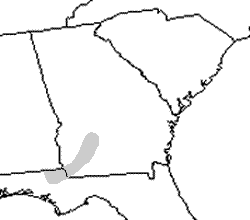Georgia Blind Salamander (Haideotriton wallacei)


Photos by J.D. Willson unless otherwise noted
| Description: Blind Salamanders are fairly small — 2-3 in. in (5.1-7.6 cm), paedomorphic (adults remain aquatic and retain larval characteristics) salamanders that are highly adapted to life in caves. They have no eyes and little pigment on their body, making them pinkish white in color and somewhat iridescent. They have long, red external gills, a broad head, and skinny legs. Have 12-13 costal grooves. They look somewhat similar to the Tennessee Cave Salamander (Gyrinophilus palleucus) and are most easily differentiated from this species by range.
Range and Habitat: Georgia Blind Salamanders are endemic to our region and are only found in a small section of southwest Georgia and adjacent Florida. However, the inaccessible habitat inhabited by this species (underground caves and springs) means that its true range is poorly documented. This species lives in caves and aquifers and is almost never seen above ground. Habits: Not much is known about reproductive strategies or other behaviors. This species may depend on guano from associated bat populations. Conservation Status: H. wallacei is state listed as threatened because of its restricted range and specific habitat requirements. The IUCN lists it as vulnerable. Pertinent Reference: Account Author: Christina Baker, University of Georgia – edited by J.D. Willson |
